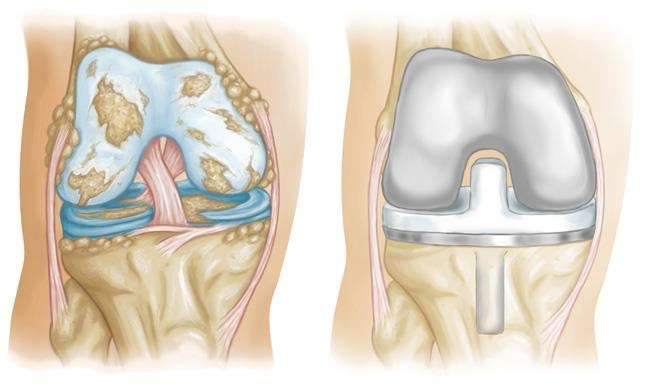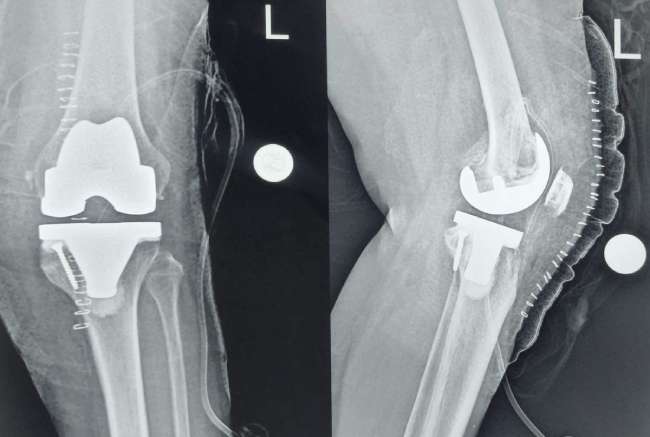Knee Replacement Surgery
What is Total Knee Replacement?
Total knee replacement is a surgical procedure in which the damaged / arthritic knee joint is replaced with an artificial joint called as prosthesis. This is commonly recommended for severe knee arthritis when other treatments fail to provide relief. Robotic assisted Total knee replacement is a surgical procedure where robotic assistance is utilised to achieve improved surgical precision. The procedure can transform the quality of life of the patient by converting a knee that is chronically painful and stiff to one which is painless and mobile.

What patient can expect before surgery?
- Detailed clinical examination to recognize the degenerative disease of the knee and the presence of additional pathologies if any. Functional scoring of the patient is done which is repeated after surgery at follow-up visits.
- X-ray of the knee to evaluate the condition of the bone and the joint and ascertain the extent of the arthritis.
- A standing scannogram is a special X-ray done to evaluate the alignment of the lower limb. The surgery aims to correct any existing deformity that is contributing to the disease process
- CT scan of the knee may be required in selected patients whose X-rays show significantly deformed bony morphology or in whom large areas of bone are deficient. This helps to better plan the surgery.
- Some patients may require an arteriovenous Doppler of the lower limb if the blood circulation of the limb is not optimum. Additionally, a CT-Angiogram may be required as an extended investigation of the Doppler.
- Preoperative physiotherapy assessment to assess the muscle strength and range of motion and to start “Pre-hab” exercises
- Anesthesia checkup to recognize potential medical issues that can affect the peri-operative course
- Additional investigations like blood tests, chest Xray, electrocardiogram (ECG), or any other test as determined by the anaesthetist/physician as being essential for surgery

Why is it Done?
Total knee replacement helps relieve severe knee pain and disability caused by:
- Osteoarthritis (cartilage wear)
- Rheumatoid arthritis (autoimmune disease)
- Knee injury or deformity with secondary degeneration of the joint
The Procedure
The surgery is usually carried out under spinal anesthesia which maybe augmented by an epidural pump for better pain control.
- The skin and soft tissues covering the knee joint are carefully separated to expose the damaged knee.
- The arthritic cartilage and underlying bone are removed from the knee joint surfaces, meaning the lower end of the femur (thigh bone) and the upper end of the tibia (shin bone) and sometimes also from the patella (knee cap).
- The ends of the femur (thighbone) and tibia (shinbone) are resurfaced with metal components of the appropriate size.
- A plastic spacer is inserted between the metal components to create a smooth gliding surface. Modern components utilize ultra-high molecular weight polyethylene (UHMWPE) which provides extended longevity.
- The knee cap (patella) may also be resurfaced with a plastic component.
- Any existing deformity of the limb (inward or outward deviation) is corrected during the surgery by altering the bone cuts or the soft tissue releases so as to correct the alignment.
- The soft tissues are repaired back and the skin incision is closed.
Recovery and Rehabilitation
- Hospital stay of 3-5 days after surgery. This may change depending upon any pre-existing medical condition. Usually, suture removal is done at 2 weeks and may not be required for stitchless surgery.
- Modern anaesthetic post operative protocols allow for significant reduction in post operative pain as compared to earlier times. Optimal pain relief in turn allows better physical rehab.
- A knee brace is used while walking in the initial postoperative period till the muscle strength improves. Use a walker/cane during early recovery. Some patients may benefit with the use of a CPM (Continuous Passive Motion) machine to increase range of motion
- Tailored physical rehab protocol that also includes activities like step-up climbing that simulate and train the patient for stair climbing.
- Full recovery takes 3-6 months for most patients
Total Hip Replacement Treatment
Risks
As with any major surgery, risks include infection, blood clots, nerve damage, and knee stiffness or instability. But complications are relatively rare. Comprehensive work up and pre anaesthesia checkup before surgery ensures minimal problems after surgery.
Longevity
Most knee replacements last >20 years before requiring revision, after which a revision replacement may be considered if necessary.
Recovery
With proper rehabilitation, commitment, and sometimes lifestyle modifications, total knee replacement can provide long-lasting pain relief and improved mobility.


